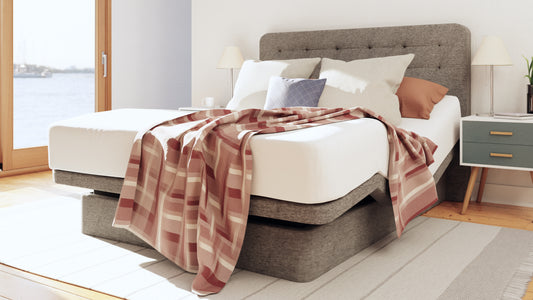If you or someone you care about finds it difficult to comfortably and safely get in and out of a traditional bed, you have likely considered an adjustable base bed. These handy beds can make life a little easier for people with illnesses or injuries that limit mobility. But you may be wondering—can you get financial help from Medicare for an adjustable base bed?
The answer depends on whether Medicare considers it an adjustable bed for comfort, or a hospital bed used for medical purposes. Hospital beds are prescribed by your doctor and meet strict criteria to qualify for Medicare coverage. Adjustable beds not sold by a Medicare supplier are usually excluded.
What is an Adjustable Base Bed?
At first glance, adjustable base beds may seem similar to hospital beds. Both can be positioned in different ways for comfort and medical needs. However, there are important distinctions between the two types of beds when it comes to Medicare coverage eligibility.
Adjustable base beds, also known as adjustable bases, are beds that can raise or lower your upper body or legs at different angles. Individuals can adjust the bed using a remote control, smart phone app, or voice command. These beds are primarily used at home for comfort and convenience.
Hospital beds have distinctive features beyond basic adjustability. Hospital beds are considered durable medical equipment, designed for medical needs like post hospital recovery or managing certain conditions.
The adjustability of a regular adjustable bed alone does not qualify it as medical equipment eligible for Medicare reimbursement. Understanding the difference between these two types of beds is helpful when evaluating options and Medicare coverage.
How are adjustable beds different from hospital beds? Here are some key differences:
- Hospital beds must meet healthcare standards for safety and reliability. Adjustable beds have different requirements.
- Hospital beds are made with adjustability to meet medical needs and for ease of caregiving. Adjustable beds are not primarily medical in nature, though may include similar features.
- Hospital beds have railings, wheels, and safety features regulated by the Food and Drug Administration (FDA) as medical devices. Most adjustable beds look more like traditional beds, and most cannot be raised or lowered as an entire unit, with the exception of the Dawn House high-low adjustable bed.
- Hospital beds are wider at 36” and are designed for utilitarian purposes to attach medical equipment or administer medications without disturbing the patient. Adjustable beds come in a variety of sizes and are often made for two people to sleep in.
In general, hospital beds are medical devices, and adjustable beds are consumer products made with comfort in mind that do not meet Medicare’s criteria as durable medical equipment. But both can make life less of a struggle for people who need extra help getting in and out of bed. [1]

What is Durable Medical Equipment (DME)?
Hospital beds prescribed by a doctor fall under the category of durable medical equipment (DME). DME is reusable medical equipment for use in your home to treat an illness or injury. For Medicare to cover DME, your doctor must confirm you medically need it. Adjustable beds simply for comfort or convenience wouldn’t qualify.
The equipment must meet the following criteria:
- Be able to handle repeated use
- Mainly serve a medical purpose, not just lifestyle benefits
- Usually not useful for someone without an illness or injury
- Be suitable for use at home
Has an expected lifetime of at least three years [2]
What Beds Can Medicare Help Pay For?
Despite the articles online promoting that Medicare Part B covers adjustable bases overall, that may be misleading information. For Medicare Part B to cover the costs of your hospital bed, your doctor and the company providing the DME must be enrolled as Medicare providers. Medicare can cover up to 80% of the cost of a hospital bed after you pay your Part B deductible.
For Medicare to help pay for a hospital bed, your doctor must document that:
- You have a medical condition requiring you to be in positions not possible in an ordinary bed.
- The hospital bed is the only kind of bed that can treat your condition.
- You need the hospital bed for home use. (Note: a hospital or nursing home providing you with Medicare-covered care does not qualify as your “home.” But a long-term facility can qualify.)
Medicare covers different kinds of hospital beds based on medical necessity, ranging from manual to electric options. However, Medicare typically does not cover full-electric beds since they are often seen as a convenience rather than essential for treatment. Most adjustable base beds are fully electric to operate the adjustability features. This differs from many hospital beds that have some electric features but also may use a hand crank system to adjust the height of the bed. Medicare will generally only cover a portion of a basic semi-automatic hospital bed, where one or more functions are operated manually, like a hand crank, and the patient’s condition requires frequent changes in body position that can’t be delayed. [3,4]
What Next Steps Should You Take to Rent a Hospital Bed?
If your doctor decides a hospital bed is necessary and writes a prescription for one, here are the key steps:
- Pick the right bed. Work with your doctor and medical supply company to choose a hospital bed that meets your medical needs and will fit comfortably in your home.
- Find a Medicare-approved supplier. Buy from a supplier enrolled in Medicare and with a Medicare supplier number because they have met the strict standards to be approved by Medicare. Ask if they “accept assignment,” meaning they agree to Medicare’s approved cost.
- Get a detailed written order. Your doctor must provide an order detailing your diagnosis, how the bed will help, and that it’s for at-home use.
- Schedule delivery. Your supplier should deliver and set up the bed for you. Make sure your home has room and outlets.
- Pay your share. With assignment, you only pay 20% of the approved cost after your Part B deductible. Without it, your share may be higher.
- Use your bed. Adjust as your doctor instructs and let them know if it isn’t meeting your needs. Medicare covers repairs and replacement parts.
For expensive DME, like a hospital bed, Medicare will cover rented hospital beds for 13 months of continuous use. Once the 13th month of rental ends, the supplier must transfer ownership of the equipment to you. Depending on the type of bed needed and the supplier’s policies, you may have the choice to purchase the bed. [5]

Image credit: peachyeung316
Are You Eligible for Coverage?
To potentially get a hospital bed covered by Medicare Part B, you must:
- Be enrolled in Medicare Part B.
- Have your doctor determine that you medically need a hospital bed.
- Have been under the care of a doctor for your condition who participates in Medicare, and you have been seen at least once in the last six months.
- Need the bed for use at home, not in a hospital or nursing home.
- Get the bed from a Medicare-approved supplier with a Medicare supplier number.
- Have your doctor provide medical necessity documentation and a detailed DME order.
You also need a condition that makes daily activities, like changing position, getting in and out of bed, or sleeping, difficult. Health issues that often qualify include:
- Severe arthritis or injury making movement hard
- Neurological conditions, like ALS
- Congestive heart failure needing elevation
- Lung diseases, like COPD, which is made worse by lying flat
- Back injury requiring traction equipment
- Severe obesity affecting mobility
Your doctor decides if your condition makes a hospital bed a medical necessity. Medicare ultimately determines if coverage requirements are met. [6,7]
Is the Dawn House Bed System Covered by Medicare?
The Dawn House bed system offers many therapeutic benefits to improve comfort and the quality of your sleep. It may be the best hospital bed alternative depending on your needs. Features like the adjustable base height, vibrating massage, optional support rail, underbed lighting, health monitoring, and zero gravity positioning can aid relaxation, reduce pain, and promote safer and better sleep. However, Medicare has stringent criteria for considering adjustable beds to be medically necessary durable medical equipment. The Dawn House bed system does not meet those requirements for Medicare reimbursement.
We encourage you to explore the Dawn House bed system to see if it is a helpful solution for your safety and sleep health. Our customer service team is happy to answer any of your questions and explain the features and benefits in more detail.
Most of all, we want to make sure you find the right bed to meet your needs and improve your comfort and quality of life.
Featured image credit: Medical billing by Nick Youngson CC BY-SA 3.0 Alpha Stock Images/cropped
References:
- https://www.fda.gov/medical-devices/general-hospital-devices-and-supplies/hospital-beds
- https://secure.ssa.gov/poms.nsf/lnx/0600610200
- https://www.medicare.gov/coverage/durable-medical-equipment-dme-coverage#
- https://www.cms.gov/medicare-coverage-database/view/ncd.aspx?NCDId=227
- https://www.medicare.gov/medical-equipment-suppliers/
- https://www.medicare.gov/media/publication/11045-medicare-coverage-of-dme-and-other-devices.pdf
- https://www.healthline.com/health/medicare/adjustable-beds-covered-by-medicare#eligibility


